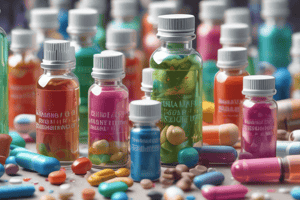Podcast
Questions and Answers
What is a potential side effect of the drug mentioned?
What is a potential side effect of the drug mentioned?
- Improved gastric health
- Enhanced muscle energy
- Skin patches (correct)
- Increased heart rate
In which patient demographic should this drug not be used?
In which patient demographic should this drug not be used?
- Patients with kidney issues
- Patients with myocardial infarction (correct)
- Patients with high blood pressure
- Patients over the age of 70
Which of the following symptoms might indicate toxicity from the drug?
Which of the following symptoms might indicate toxicity from the drug?
- Increased appetite
- Normal pulse
- Bradycardia (correct)
- Rapid weight gain
What effect can the drug cause within minutes of administration?
What effect can the drug cause within minutes of administration?
What is the rationale for avoiding this drug in certain patients?
What is the rationale for avoiding this drug in certain patients?
What role does the sympathetic nervous system play in blood flow regulation?
What role does the sympathetic nervous system play in blood flow regulation?
What condition could potentially lead to decreased coronary artery blood supply?
What condition could potentially lead to decreased coronary artery blood supply?
What might cause an increase in myocardial oxygen consumption?
What might cause an increase in myocardial oxygen consumption?
How can certain medications impact coronary artery function?
How can certain medications impact coronary artery function?
What is a significant factor that can diminish blood supply during stress?
What is a significant factor that can diminish blood supply during stress?
Which of the following describes a potential effect of insufficient blood supply to the heart?
Which of the following describes a potential effect of insufficient blood supply to the heart?
What physiological change can occur as a result of sympathetic activation?
What physiological change can occur as a result of sympathetic activation?
What can exacerbate conditions leading to coronary artery issues?
What can exacerbate conditions leading to coronary artery issues?
What is the primary role of action potentials in neuron signaling?
What is the primary role of action potentials in neuron signaling?
Which ion is primarily responsible for the depolarization phase of an action potential?
Which ion is primarily responsible for the depolarization phase of an action potential?
What characterizes a non-selective receptor?
What characterizes a non-selective receptor?
How does bronchospasm affect the respiratory system?
How does bronchospasm affect the respiratory system?
What is the consequence of ventricular tachycardia?
What is the consequence of ventricular tachycardia?
In the context of cardiac function, what is 'resting potential'?
In the context of cardiac function, what is 'resting potential'?
What does the term 'action potential' specifically refer to?
What does the term 'action potential' specifically refer to?
Which condition is often associated with dysregulation of impulse conduction?
Which condition is often associated with dysregulation of impulse conduction?
What is the primary concern associated with limited coronary artery blood supply?
What is the primary concern associated with limited coronary artery blood supply?
Which factor is most likely to worsen coronary artery conditions?
Which factor is most likely to worsen coronary artery conditions?
What is a potential consequence of venous blood supply being limited during ischemic conditions?
What is a potential consequence of venous blood supply being limited during ischemic conditions?
In the context of coronary artery health, what does spasm refer to?
In the context of coronary artery health, what does spasm refer to?
How might age influence drug storage and administration in coronary artery disease treatment?
How might age influence drug storage and administration in coronary artery disease treatment?
What might be a common non-pharmacological approach to manage coronary artery conditions?
What might be a common non-pharmacological approach to manage coronary artery conditions?
What role does skin irritation play in the context of drug patches for coronary artery disease treatment?
What role does skin irritation play in the context of drug patches for coronary artery disease treatment?
What is a significant risk associated with coronary artery spasm?
What is a significant risk associated with coronary artery spasm?
Flashcards
Action Potential
Action Potential
A rapid change in membrane potential of a neuron or muscle cell, essential for nerve impulse transmission.
Resting state
Resting state
The state of a neuron or muscle cell when it's not transmitting an impulse.
Non-selective Channels
Non-selective Channels
Channels that allow many types of ions to pass through, without selectivity.
Impulse
Impulse
Signup and view all the flashcards
Phase 0
Phase 0
Signup and view all the flashcards
Depolarization
Depolarization
Signup and view all the flashcards
Tachycardia
Tachycardia
Signup and view all the flashcards
Bronchospasm
Bronchospasm
Signup and view all the flashcards
Toxicity Blockers
Toxicity Blockers
Signup and view all the flashcards
Blood Flow
Blood Flow
Signup and view all the flashcards
Coronary Artery Spasm
Coronary Artery Spasm
Signup and view all the flashcards
Sympathetic Nervous System
Sympathetic Nervous System
Signup and view all the flashcards
Heart Rate (HR)
Heart Rate (HR)
Signup and view all the flashcards
Respiratory Rate (RR)
Respiratory Rate (RR)
Signup and view all the flashcards
Blood Pressure
Blood Pressure
Signup and view all the flashcards
Blood Supply
Blood Supply
Signup and view all the flashcards
Angina
Angina
Signup and view all the flashcards
Limited Blood Supply
Limited Blood Supply
Signup and view all the flashcards
Storage of Drugs
Storage of Drugs
Signup and view all the flashcards
Drug Patches
Drug Patches
Signup and view all the flashcards
Skin Irritation
Skin Irritation
Signup and view all the flashcards
Migraine Read
Migraine Read
Signup and view all the flashcards
Prophylactic Treatment
Prophylactic Treatment
Signup and view all the flashcards
Ivaniprant
Ivaniprant
Signup and view all the flashcards
Nitrate
Nitrate
Signup and view all the flashcards
Digoxin
Digoxin
Signup and view all the flashcards
Bradycardia
Bradycardia
Signup and view all the flashcards
Toxicity
Toxicity
Signup and view all the flashcards
Study Notes
References
- Karch, A. M. (2020): Focus on nursing pharmacology, 8th Edition, Lippincott Williams & Wilkins, ISBN: 978-1-9751-0096-4, Chapter 44: 2294-2352
Drugs Acting on Cardiovascular System
- Antiarrhythmic Agents
The Conducting System of the Heart
- SA node
- AV node
- Bundle of His
- Right bundle branch
- Left bundle branch
- Purkinje fibers
Five Phases of the Action Potential of the Cardiac Muscle Cell
- Phase 0: Occurs when the cell reaches a point of stimulation
- Phase 1: Short period during which sodium ion concentration equalizes inside and outside of the cell
- Phase 2: (Plateau Stage): Occurs as the cell membrane becomes less permeable to sodium, calcium slowly enters the cell and potassium begins to leave the cell
- Phase 3: Repolarization
- Phase 4: The cell comes to rest; the sodium-potassium pump returns the membrane to its resting membrane potential.
Causes of Cardiac Arrhythmias
- Electrolyte disturbances that alter the action potential
- Structural damage
- Pathway changes
- Acidosis of waste products
- Drugs that alter action potential or cardiac conduction
Types of Cardiac Arrhythmias
- Tachycardia (faster heart rate)
- Bradycardia (slower heart rate)
- Premature atrial contractions (PACS)
- Premature ventricular contractions (PVCs)
- Atrial flutter
- Atrial fibrillation or (ventricular fibrillation)
- Heart Blocks
- Bundle branch blocks
Classifications of Antiarrhythmics
- Class I: Block sodium channels in the cell membrane during an action potential
- Class II: Block beta-receptors, causing a depression of phase 4 of the action potential
- Class III: Block potassium channels, prolonging phase 3 of the action potential
- Class IV: Block calcium channels in the cell membrane
Use of Antiarrhythmic Across the Lifespan
- Children: Minimized use, careful monitoring for adverse effects, and calculated dosing based on weight and age.
- Adults: Monitor total drug regimen, frequent monitoring, and medical follow-up.
- Older adults: Start with lower doses, monitor closely, and adjust based on response.
Prototype Class I Antiarrhythmic - Lidocaine
- Indications: Management of acute ventricular arrhythmias, typically during cardiac surgery or acute myocardial infarction (MI)
- Route: IV administration
- Actions: Decreases depolarization, resulting in fewer impulses. Increases ventricular fibrillation threshold
- Adverse effects: Dizziness, light-headedness, fatigue, arrhythmias, cardiac arrest, and nausea
- Usual indications: Treatment of life-threatening ventricular arrhythmias, also used during acute myocardial infarction (MI) and cardiac surgery.
Class II Antiarrhythmic - Propranolol
- Indications: Treats cardiac arrhythmias (particularly supraventricular tachycardias)
- Route: Oral or IV
- Actions: Blocks beta-receptors, decreasing heart rate, and cardiac excitability
- Adverse effects: Bradycardia, heart failure, cardiac arrhythmias, heart blocks, cerebrovascular accident
- T1/2: 3 to 6 hours
Class III Antiarrhythmic- Amiodarone
- Indications: Life-threatening ventricular arrhythmias
- Route: Oral or IV
- Actions: Primarily prolongs action potential
- Adverse effects: Malaise, fatigue, dizziness, heart failure, cardiac arrhythmias, cardiac arrest
Class IV Antiarrhythmic - Diltiazem
- Indications: Paroxysmal supraventricular tachycardia (SVT) in Adults
- Route: Oral or IV
- Actions: Blocks movement of calcium ions, slows automaticity and conduction through AV node
- Adverse effects: Dizziness, light-headedness, headache, asthenia, peripheral edema, bradycardia
Other Drugs Used to Treat Arrhythmias
- Adenosine (Adenocard): Used to convert supraventricular tachycardia to sinus rhythm
- Digoxin: Slows calcium from leaving cell, prolonging action potential
- Dronedarone (Multaq): Reduces risk of hospitalization in patients with persistent atrial fibrillation (AF).
Nursing Considerations for Antiarrhythmic Therapy
- Assess patient history and physical exam (allergies, kidney/liver function, hypotension, shock, electrolyte imbalances.)
- Pregnancy and lactation status
- Baseline ECG, and appropriate lab values
Coronary Artery Disease (CAD)
- Definition: narrowing of the heart arteries.
- Symptoms: Stable angina, unstable angina, myocardial infarction.
Types of Angina
- Stable Angina: Partial blockage with typical chest pain relieved with rest or medication
- Unstable Angina: Increasing chest pain not relieved by rest or medication.
- Prinzmetal’s Angina: Related to coronary spasm
Actions of Antianginal Drugs
- Improved blood delivery to heart muscle
- Increased oxygen delivery
- Decreasing the heart's workload
- Decreasing oxygen demand
Factors Affecting Myocardial Oxygen Demand
- Myocardial oxygen consumption, heart rate,
- Blood volume (preload), blood pressure (afterload)
- Left ventricular muscle size, muscle contractility
Use of Antianginal Agents across the Lifespan
- Consideration of age-related physiological changes to adjust drug dosages.
- Monitoring patients for adverse reactions
Question 1
- Swallowing the sublingual tablet is incorrect. The tablet needs to be placed under the tongue.
Question 4
- Bronchospasm is a known side effect of the class II antiarrhythmics
Question 3
- Increasing absorption is the primary reason why nitroglycerin is given sublingually; it's intended to avoid first-pass metabolism by the liver.
Question 2
- Pounding headaches can result from vasodilation of cerebral vessels caused by nitrates' effects
Studying That Suits You
Use AI to generate personalized quizzes and flashcards to suit your learning preferences.




